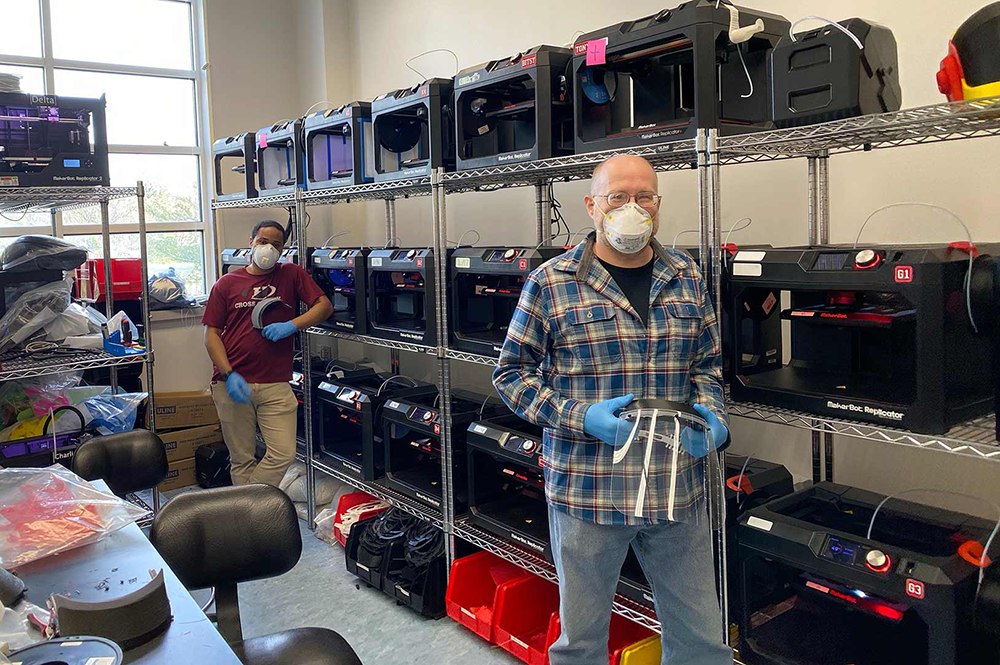
|
 |
Terrapin Works staff Nathanael Carriere (left) and Andy Gregory attend banks of 3D printers turning out protective gear and other equipment for front-line personnel fighting the pandemic. (Photos courtesy of Terrapin Works) |
|
When everything is normal, Terrapin Works is the University of Maryland’s on-campus full-spectrum rapid prototyping and design facility, as capable of turning out a simple 3D-printed plastic bauble for a student project as an elaborately formed part for an engine or spacecraft design.
But in the midst of the COVID-19 pandemic, Terrapin Works’ normal activity has come to a halt, and the staff and faculty who work there have dedicated many of its 100 3D printers and other advanced machinery to collaborating with medical professionals to create necessary tools.
“We’re trying to be responsive to the medical community with things that we think additive manufacturing can help with,” said Jim Zahniser, assistant dean of strategic operations and IT in the A. James Clark School of Engineering.
Their list of projects is diverse, from gadgets that reduce the likelihood of people doing coronavirus research on campus inadvertently passing along the virus themselves, to devices that could safeguard the lives of doctors and nurses.
One example of the latter is an intubation box to help reduce the spread of respiratory droplets and aerosols while patients are being placed on a ventilator. After a Taiwanese doctor posted a basic version online that “caught like wildfire,” Dr. Jason Brookman, an assistant professor of anesthesiology at the University of Maryland School of Medicine, contacted Terrapin Works about building one at Maryland. Intubating patients, Brookman said, is one of the highest risk procedures for health care workers caring for COVID-19 patients, because a cough or sneeze while placing the breathing tube can spray droplets and aerosls up to 25 feet in a second , potentially infecting clinicians with the virus.
The intubation box is a clear shell placed over a patient’s head with arm ports so a doctor can reach inside, and filtration ports where tubes are connected to filter out contaminated air and push in fresh air.
Kevin Aroom, a senior research engineer at the Fischell Institute for Biomedical Devices, and Ethan Reggia, a design consultant for Terrapin Works and head of engineering at Pathotrak, have been leading the project. They are working with Brookman to modify the original design.
“The goal of our version is to create a mostly sealed, negatively pressurized box, which means you’re pulling air out of it faster than any air could escape,” Reggia said.
They are awaiting emergency use authorization from the FDA to use the intubation boxes in hospitals. This design could have lasting impacts beyond the COVID-19 pandemic, Brookman said.
Personal protective equipment is another big focus for Terrapin Works. While N95 masks are in short supply and high demand, Terrapin Works is manufacturing face shields as a temporary solution to help bridge the gap. The organization can print 50 face shields in three hours, and is using the six 3D printers at the School of Architecture, Planning and Preservation to maximize production. Terrapin Works has received more than 1,000 face shield orders.
Face shields help to prevent N95 masks, which health care workers frequently reuse, from being soiled by virus-laden droplets in the air.
“If it gets on the outside of the mask, the mask is spoiled,” Zahniser said. “Getting a face shield that people can wear while they’re wearing these masks can prevent [droplets] from hitting the mask, and instead it’s on the face shield that can get wiped off or thrown away.”
Although Terrapin Works isn’t facing difficulties as dire as those of medical personnel and first responders nationwide, it is still navigating the loss of 90% of its workforce: undergraduate students. With students not allowed in the laboratories, professional staff is doing more of the hands-on work.
Without students, Nathanael Carriere, the operations manager, runs the printers, troubleshoots issues, and orders materials. He also drives all over the state—from Annapolis and Baltimore to out near Delaware—to pick up materials.
“There’s so much need in this time for people to step up,” Carriere said. “We as an organization can do so much, so I think it’s our duty to do everything we can to support and assist those efforts.”
While away from labs and workspaces, Terrapin Works’ undergrads are finding ways to continue their work from home. John Fitzell ’20 and Eli Fastow ’20 both have software on their computers that allow them to complete their work and send it to the 3D printers on campus.
Both are working on the custom N95 masks. Once they get face scans back from the doctors, they adjust the basic design and send them to print on campus.
“I got involved with bioengineering because being able to see the impact of what you’re designing being used and helping people immediately after you give it to them is a really meaningful and powerful thing to do,” said Fitzell, a bioengineering major.
It’s not just the students’ extra hands that are missed. Carriere said students are part of the culture and help make Terrapin Works what it is.
“Students are the lifeblood of the university, and they’re definitely the lifeblood of our organization,” Carriere said. “We’re happy to have them in any way that we can.”
This story originally appeared on Maryland Today.
Related Articles:
COVID-19 Engineering Solutions: In the News
Sci-Fi Social Distancing?
Maryland Engineers Receive Coronavirus Research Seed Fund Awards
Protection Collections Abound for Local Health Care Workers
Public health planners: Free resources for emergency health clinics
Clark School Engineers Create Solutions for a Crisis
April 27, 2020
|